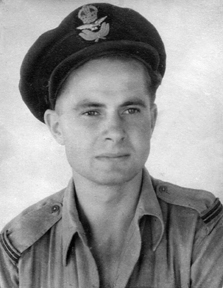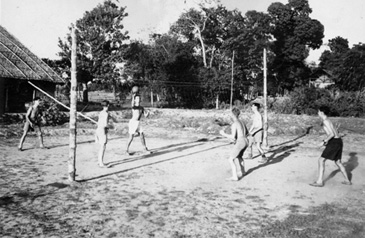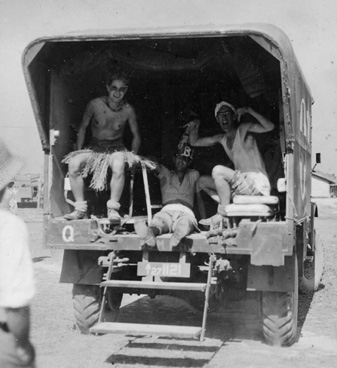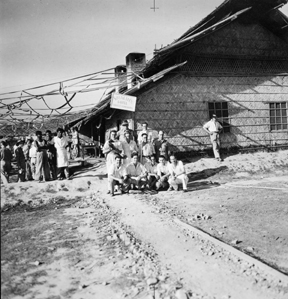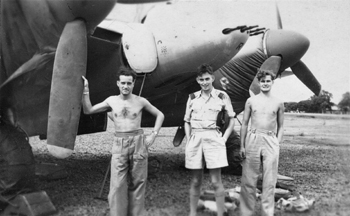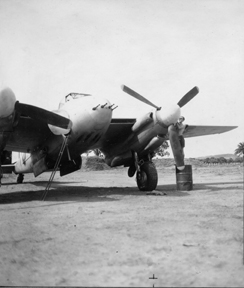 |
 |
|||||||
|
F/Lt Peter Spooner 152082 RAFVR 1922—2008 Shortly before Christmas 2003, I had a letter from Peter Spooner by way of his son, Phil. Peter’s letter was a wonderful surprise for the light it shed on several matters, very much appreciated by the various families involved. Carefully preserved over the years by the late Des Marsh-Collis and his family, the typed narrative of 211 Squadron in India and Burma had included a number of small puzzles of usage which suggested that it had been of Service origin, later overlaid with some difficulties in transcription by non-Service hands. Peter Spooner and his wife Pamela had by then been living in Buckinghamshire for some years. At Christmas-time in Burma 58 years before, Peter was about to be posted from 211 Squadron. Therein lay the answer to the above puzzles, as he readily explained in the personal narrative which follows. Thus that long-treasured account of the squadron’s operations in India and Burma now has its own page, now embellished (like this one) with a number of photographs from Peter’s collection, scanned by Phil. With thanks, then, to Peter and to Phil, to Eveline Marsh-Collis, her daughters Jane and Imelda, and Imelda’s husband Aidan Simons...between them, the two families have contributed much to the Squadron’s story. The Narrative of Peter Spooner
I was an RAF navigator/wireless operator who joined 211 Squadron at Chiringa in November 1944, clocked up 27 operational sorties before the switch from Beaufighters to Mosquitoes, and left the squadron from Don Muang shortly before Christmas 1945. It was I who produced the squadron history recently sent to you by Mrs Marsh-Collis. I wrote it between 8:00pm and 4:00am on November 30-December 1, my last night with the squadron. Let me explain why I was engaged in this nocturnal activity instead of drinking farewell to my fellow aircrew. The CO had given me the job of producing an account of the squadron's activities in India, Burma and Thailand, and I had spent some time assembling the necessary facts and figures. Just as I was about to put pen to paper, my pilot (Flt Lt Jock Russell, now deceased) and I were mysteriously recalled to the UK for some kind of joint training. This was clearly an administrative blunder because Flt Lt Russell was older than me and had no intention of postponing his demobilisation. Nonetheless we were due to board a Dakota to Calcutta early the following morning. For my squadron history it was a case of now or never. Someone somewhere up or down the line had also spotted the blunder because a signal cancelling the recall arrived soon afterwards. By then we were fired with the prospect of getting home for Christmas; after all, the war was over and there were rumours that 211 Squadron would soon be disbanded. The most sensible course, it seemed to us, would be to act promptly on the first signal and ignore the second. In that duplicity (which hardly ruffles my conscience after 58 years!) we were aided and abetted by a sympathetic adjutant, long deceased. He gave us just thirty minutes to get clear of the station before he officially received the cancellation. At Calcutta we were reluctant to contact any RAF establishment in case we were put on a plane back to Don Muang. An air traffic officer, fortuitously encountered in a bar that evening, solved that dilemma by allowing us to hitch a ride on a Sunderland flying boat taking tea planters and sundry civil servants back to the Old Country. No seats - just dirty mattresses in the Sunderland's hull. Our journey home took seven days, with landings at Karachi, Bahrein, Cairo, Augusta, Marseilles and Biscarosse. It became increasingly nerve-racking as time went by. Would a recall signal catch up with us before we disembarked at Poole? The authorities didn't know what to do with me when I arrived so they sent me on indefinite leave. This went on so long that I returned, temporarily, to my civilian job as a magazine sub-editor. Eventually I was posted to Department 10A at the Air Ministry building at the bottom of Kingsway, a unit that, somewhat ironically, processed RAF reservists' applications to delay demobilisation. I myself was demobbed, on schedule, that summer. The 211 history had been laboriously written in longhand but I had managed to take a carbon copy for myself. This remained tucked away in a box of war-time souvenirs until the early 'nineties. I then donated it to a local group of 'aircraft recovery' enthusiasts. They put it on display, along with other RAF memorabilia, at the former Enigma code-breaking establishment at Bletchley Park, now open to the public. I assumed that the top copy was rotting away in some forgotten Air Ministry file. So it was a surprise - and a thrill - to encounter it, virtually unchanged, on the Internet. Hopefully, this exposure will stir up memories, some sad perhaps, for other survivors of a squadron whose history came to a full stop during the first Spring of peacetime. Peter Spooner 211 Squadron 1944—1945
On most days, tea-time in the late afternoon saw a game of volley-ball in play on this court outside the attap Officer’s mess.
The Christmas hi-jinks included the comic football match described in the India and Burma narrative, and a performance of “Sister Hannah”. The football match, probably between ‘A’ Flight and ‘B’ Flight, was played in improvised fancy dress. F/Lt Spooner confesses to being the grass-skirted beauty on the left, above. The acting CO, Bob Dagnall, was taken as a “stretcher case” to this ambulance and on to the football field. High spirits.
Soyalinx Hotel Chiringa Christmas 1944 (P Spooner) The cookhouse brigade pose for a happy shot. The quadrangle between the huts was the alfresco dining room for the airmen’s Christmas dinner, hence the festive decorations festooned overhead. The sign proclaims “Soyalinx Hotel: Light (very light) Luncheons”. The soymeal snag of war-time rations was not a popular culinary item.
The Mosquito is R-Roger (RF756), photographed at St Thomas Mount. The engine cover is marked P (port engine).
Afterthoughts The original was laboriously handwritten on poor quality off-white paper. No doubt the adjutant (Flt.Lt. Kent, long deceased) had it typed before sending it up the line. Some minor errors and/or changes may have occurred during that transcription. As I have explained, I wrote the history through the night before my departure from Don Muang and my handwriting deteriorated as the deadline approached! My own carbon copy remained tucked away, with other RAF souvenirs, for nearly half a century. Then I made several copies on a primitive word processor. The carbon copy had begun to break up, so I had difficulty with some names. I then gave the carbon copy and a typed copy to a local Air Recovery Group, who included it in a modest 'air war in Burma' display at Bletchley Park. The carbon copy has now vanished, as I found on a visit there last weekend [January 2004] [...] It is, however, worth looking at the last text paragraph. When I penned this [the last paragraph] I did not know if or when Air Ministry would act on Air Marshal Saunders' recommendation that 211 Squadron should disband. So the original text signs off with the words: "This ends with November [1945]. The fate of 211 Squadron hangs in the balance. Whatever happens, the spirit of the squadron will be preserved." When I made that prophecy I didn't know about the Internet! This is a remarkable story, not only in its own right but in the insight it gives us into how real history, with real records, real people and real goodwill, develops. The kaleidoscope of past and present He put quite a lot of store in preserving the past, his own keen interest being cinema history. Over the years he gathered an impressive collection of equipment and movies from the silent era, taking the trouble to make modern transfers of even the oddest of formats and of films which, he cheerfully noted, were largely unheard of. He and Pamela had their 65th wedding anniversary in July 2008. From time to time Peter remarked composedly or with good humour on the passing of the years and their varying state of health. When all was well, he was wont to say they were “both tottering on pretty well, thank you”. With some assistance from son Phil, he took to the PC era with with characteristically wry enthusiasm, referring from time to time to his “wretched machine”—a view with which I quite agree! It was always a pleasure to correspond with Peter, whether the news was good or less so. “All things have rest” Sources www.211squadron.org © D Clark & others 1998—2025 |
|||||||
